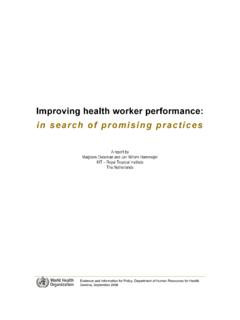Transcription of Surgical skin disinfection guideline - Queensland Health
1 guideline [Optional heading here. Change font size to suit]. Surgical skin disinfection guideline 1. Purpose This guideline provides an overview of Surgical skin preparation and the rationale for the selection and use of skin disinfection within the operating suite. 2. Scope This guideline provides information for all employees, contractors and consultants within the Queensland Health . 3. guideline for Surgical skin disinfection KEY CRITICIAL POINTS. Thorough cleaning of the Surgical incision site can reduce the incidence of Healthcare Associated Infection (HAI). Product selection including strength should be determined after consideration of numerous factors specific to the patient and the facility.
2 Introduction This guideline provides an overview of Surgical skin preparation and the rationale for the selection and use of skin disinfection within the operating suite. Surgical Site Infections (SSI) are one of the most common and costly Healthcare Associated Infections (HAI) among hospitalised patients.(1) These infections have been found to result in increased length of stay, additional costs and have the potential for increased morbidity and mortality.(1-8). A Surgical site infection occurs when bacteria enter a Surgical wound.(6, 9) This most commonly happens in the operating room, where bacteria can come from several sources, including the environment, the staff and the patient.
3 Most SSIs originate from the patient's own bacteria, which enter the wound during the Surgical procedure, however infections from exogenous sources also occur.(5-7, 9, 10). Reducing the number of bacteria on the skin around the incision site reduces the risk of a patient developing a SSI.(4-7, 10) This can be achieved through Surgical skin disinfection , which removes transient bacteria and reduces resident bacteria through a combination of mechanical removal, chemical killing and inhibition.(4, 7, 9). Several antiseptic agents are available for preoperative preparation of skin at the incision site. Chlorhexidine gluconate, the iodophors and alcohol containing products are the most commonly used agents.
4 (2, 5). Version No.: <no> ; Effective From: <date> Page 1 of 7. Version No.: <no> ; Effective From: <date> Page 1 of 7. Page 1 of 3. Department of Health : Surgical skin disinfection guideline Chlorhexidine gluconate Chlorhexidine gluconate kills a range of Gram positive and Gram negative bacteria(4, 6), viruses and fungi, and binds to the top layer of the skin , which results in persistent activity.(1, 2, 5, 9, 11). Chlorhexidine does not become inactivated in the presence of organic material.(1, 5, 6). Iodophors ( povidone iodine). Povidone iodine kills a range of Gram positive and Gram negative bacteria, viruses and fungi.(4-6, 9). The povidone carrier releases its iodine slowly; the iodine kills bacteria quickly but does not have a residual effect.
5 (9) Iodine is inactivated by organic material so should only be applied to clean skin .(5, 6, 9). Alcohol Alcohol kills a range of Gram positive and Gram negative bacteria and many viruses and fungi.(4-6, 9). The immediate antimicrobial activity of alcohol is stronger and kills more quickly than chlorhexidine gluconate or povidone iodine, but has no residual effect.(1, 5, 6, 9, 11, 12). Antiseptic combinations Significant immediate activity is required before Surgical incision, in addition to some persistent activity for the duration of the procedure.(12) Persistence of the antimicrobial effect suppresses the regrowth of residual skin flora not removed by preoperative prepping, as well as transient micro- organisms contacting the prepped site.
6 Therefore, the strong immediate action of alcohol in combination with the persistent activity from chlorhexidine gluconate or the slow release of iodine from iodophors is ideal.(1, 2, 11, 12). Use alcohol-containing preoperative skin preparatory agents if no contraindication exists. Consideration must also be given to the site to be prepped as the use of chlorhexidine or alcoholic solutions may be contraindicated, for example traumatic wounds, eyes, ears and/or mucous membranes.(1, 6, 11)The most effective disinfectant (chlorhexidine or povidone iodine) to combine with alcohol has not been established in the literature. A comparison of various strengths of chlorhexidine gluconate in isopropyl alcohol would be needed to conclusively determine the recommended strength of the chlorhexidine.
7 In the absence of such evidence, the strength of chlorhexidine gluconate used should be determined in collaboration with the local infection control committee and be based on local factors such as SSI rates and infection characteristics, such as commonly affected Surgical sites and causative micro-organisms. Decisions on viability of solutions once opened and stored need to be made locally after adequate risk assessment, in consultation with but not limited to representatives from local infection management services and pharmacy service, taking into consideration local factors and the environment in which the solution will be used. Page 2 of 3.
8 Department of Health : Surgical skin disinfection guideline Guidelines for use Product selection Before a product is selected for Surgical site disinfection the clinician should consider the following points (4, 5, 7, 9): patient sensitivity or allergy operative site condition of the patients skin presence of organic matter, including blood the surgeon's preference local SSI rates contain broad spectrum properties significantly reduce micro-organisms on intact skin be non-irritating and non-toxic be rapid acting have a persistent effect be compatible with other products used in operative skin preparation, such as pre-operative bathing be included on the Australian Register of Therapeutic Goods (ARTG).
9 Use alcohol-containing preoperative skin preparatory agents if no contraindication exists. The most effective disinfectant (chlorhexidine or povidone iodine) to combine with alcohol has not been established in the literature. Note: The same antimicrobial agent shall be used for all phases of the patient's skin preparation, to ensure full residual benefit and consistent action.(7). Pre-operative showering/bathing The efficacy of antiseptic agents is dependent on the cleanliness of the skin . Removal of superficial soil, debris, and transient microbes before applying antiseptic agents reduces the risk of wound contamination by decreasing the organic debris on the skin .
10 (5-7). Unless contraindicated, advise patients to shower or have a bath (or help patients to shower, bath or bed bath) using soap, either the day before, or on the day of, surgery.(3, 10, 13-15). Hair removal Hair at the Surgical site should be left in place whenever possible as studies have found that preoperative shaving of the Surgical site increases the risk of Surgical site infection.(1, 3, 5, 16). If the presence of hair will interfere with the Surgical procedure the following precautions should be taken: hair removal should be performed the day of surgery, in a location outside of the operating theatre or procedure room(1, 7, 10). only hair interfering with the Surgical procedure should be removed(5).












